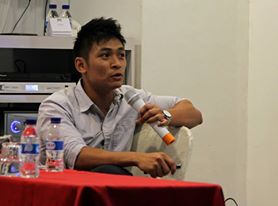The Jalan Kubor Cemetery
1As part of Bukit Brown : Our Roots, Our Future, a series of talks were programmed to enrich the exhibition which was held at the Chui Huay Lim Club, the co-organiser of the exhibition.
Speaker Dr Imran bin Tajudeen gave insights into Singapura’s Historic Cemetery at Jalan Kubor which has royal roots. Several old settlements existed in Singapore besides the Temenggong’s estuarine settlement at Singapore River before Raffles’ arrival in 1819. Among these, Kampung Gelam and the Rochor and Kallang River banks were also sites of historic graveyards related to old settlements of Singapura both before and during colonial rule. The Jalan Kubor cemetery is the only sizable cemetery grounds still largely undisturbed. It belongs with Kampung Gelam history but has been excluded from the “Kampong Glam Conservation District” boundary, and is important for several reasons. It forms part of the old royal port town that was developed when Tengku Long of Riau was installed as Sultan Hussein in Singapore, and is aligned along the royal axis of the town. It is also the final resting place of several traders of diverse ethnicity from the old port towns of our region – neighbouring Riau, Palembang, and Pontianak, as well as Banjarmasin and the Javanese and Bugis ports further afield. Some of these individuals are buried in family enclosures, mausolea, or clusters. Conversely, there are also hundreds of graves of unnamed individuals from Kampung Gelam and surrounding areas. The tombstone forms and epigraphy reflect this immense socio-cultural diversity, and were carved in Kampung Gelam by Javanese and Chinese stone carvers, except for a number of special cases. Several large trees of great age are also found in this lush ‘pocket park’. The talk discusses the histories that can be retrieved from this important site and the dire need to protect it.
Speaker’s Bio
Dr Imran bin Tajudeen is an Assistant Professor at the Department of Architecture, NUS. His research interests centre around vernacular urbanism, house and mosque architecture in Southeast Asia, and critical perspectives in urban heritage studies. Of relevance to this talk is his article, ‘Reading the Traditional City in Maritime Southeast Asia: Reconstructing the 19th century Port Town at Gelam-Rochor-Kallang, Singapore,’ published in the Journal of Southeast Asian Architecture in 2005. His research papers have won prizes at major international conferences, including the ICAS Book Prize 2011 for the best PhD paper in the field of Social Sciences.
———————————————————————————————————
Part 1 and Part 2 of theEnglish talks from other speakers are also available.


I like the old wooden hsoues much more then apartment blocks which look so sterile. The house in the picture looks homely and friendly. It is a shame that the old wooden hsoues are not preserved. I guess there are more and more people needing living space and it is the way up!